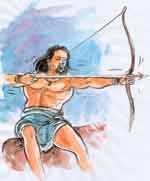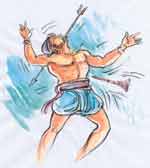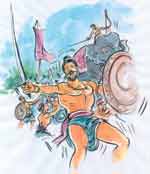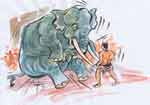 1.
After gaining victory in a number of battles, the king decided
to set camp, on the banks of the river. On the other side of the
river was an enemy camp. Soldiers of both armies were in the habit
of taking their morning exercises. King Dutugemunu too, joined
the soldiers. There is an interesting episode coming down from
legend, to which the chronicles do not refer. According to this
legend, just as the king starts his morning exercises, a piper
from the enemy camp just opposite, starts jeering at the king
and playing his pipe to annoy the king. When this mockery was
repeated daily, the king was very annoyed.
1.
After gaining victory in a number of battles, the king decided
to set camp, on the banks of the river. On the other side of the
river was an enemy camp. Soldiers of both armies were in the habit
of taking their morning exercises. King Dutugemunu too, joined
the soldiers. There is an interesting episode coming down from
legend, to which the chronicles do not refer. According to this
legend, just as the king starts his morning exercises, a piper
from the enemy camp just opposite, starts jeering at the king
and playing his pipe to annoy the king. When this mockery was
repeated daily, the king was very annoyed.
2. The king
had a clever archer named Manapathirana. Believing in the tales
carried by other men about this archer, the king had dismissed
him from service, some time ago. This archer was leading a quiet
life in a village named Vendaru. The king got to know about this.
One fine day, when the Tamil piper began to play his pipe to annoy
the king, the king said, “If only Manapathirana was here,
that Tamil piper dare not insult me like this”.
 3.
A minister who heard this, asked the king whether he is to go
and get Manapathirana. The king at once gave permission; and the
archer was brought before the king. The king enrolled him in the
king’s service once again. When the king told him about
the enemy piper, Manapathirana said, “O’ King. If
only you permit me, I’ll shoot an arrow and see that he
is silenced for ever”. The king gave the permission.
3.
A minister who heard this, asked the king whether he is to go
and get Manapathirana. The king at once gave permission; and the
archer was brought before the king. The king enrolled him in the
king’s service once again. When the king told him about
the enemy piper, Manapathirana said, “O’ King. If
only you permit me, I’ll shoot an arrow and see that he
is silenced for ever”. The king gave the permission.
4. As usual,
the following day, when the king started the piper’s morning
exercises, this man began to play his pipe. Manapathirana shot
an arrow, which went through the pipe and pierced his mouth. The
man was about to fall on his back. Manapathirana then shot another
arrow direct to his knee, which made him fall down, as if bowing
to the king. He died there. Highly taken up with the archer’s
precision at shooting, the king made him the chief of his village.
None of our chronicles mention this and so it is pure legend.
 5.
The Sinhala army was successful in defeating a number of clever
Tamil commanders. So the king was able to capture all the places
held by the enemy. This process took a long time and a lot of
human lives were lost in battle. The religious leaders were against
this policy of the king and started blaming him, for killing people
mercilessly.
5.
The Sinhala army was successful in defeating a number of clever
Tamil commanders. So the king was able to capture all the places
held by the enemy. This process took a long time and a lot of
human lives were lost in battle. The religious leaders were against
this policy of the king and started blaming him, for killing people
mercilessly.
6. When the
king heard about this criticism leveled against him, he announced
thus, “I so not fight for my personal glory. This struggle
is to re-establish Buddhism in this country”. This proclamation
silenced everybody. The king got organized for his next battle.
His next target was Vijithapura – which was the biggest
fortress of the Tamils. There were a number of great warriors
defending this fortress.
 7.
When the camps on the banks of the river were attacked, whoever
survived, joined the numbers at Vijithapura. King Dutugemunu was
aware of the strength of the enemy and did not want to fight aimlessly.
He camped close to Vijithapura. The king applied all the strategies
he had mastered. Meanwhile he wanted to test the strength of his
warriors. He got the elephant Kandula, intoxicated and infuriated
him by the beat of drums and the blowing of horns. Kandula ran
berserk.
7.
When the camps on the banks of the river were attacked, whoever
survived, joined the numbers at Vijithapura. King Dutugemunu was
aware of the strength of the enemy and did not want to fight aimlessly.
He camped close to Vijithapura. The king applied all the strategies
he had mastered. Meanwhile he wanted to test the strength of his
warriors. He got the elephant Kandula, intoxicated and infuriated
him by the beat of drums and the blowing of horns. Kandula ran
berserk.
8. The warrior
Nandimitra who noticed the violent nature of the elephant, went
towards the animal and caught him by his tusks. He gradually made
the elephant sit on the ground. Seeing Kandula tamed, soldiers
cheered and praised Nandimitra for his bravery and strength. The
king was highly pleased.
 1.
After gaining victory in a number of battles, the king decided
to set camp, on the banks of the river. On the other side of the
river was an enemy camp. Soldiers of both armies were in the habit
of taking their morning exercises. King Dutugemunu too, joined
the soldiers. There is an interesting episode coming down from
legend, to which the chronicles do not refer. According to this
legend, just as the king starts his morning exercises, a piper
from the enemy camp just opposite, starts jeering at the king
and playing his pipe to annoy the king. When this mockery was
repeated daily, the king was very annoyed.
1.
After gaining victory in a number of battles, the king decided
to set camp, on the banks of the river. On the other side of the
river was an enemy camp. Soldiers of both armies were in the habit
of taking their morning exercises. King Dutugemunu too, joined
the soldiers. There is an interesting episode coming down from
legend, to which the chronicles do not refer. According to this
legend, just as the king starts his morning exercises, a piper
from the enemy camp just opposite, starts jeering at the king
and playing his pipe to annoy the king. When this mockery was
repeated daily, the king was very annoyed. 3.
A minister who heard this, asked the king whether he is to go
and get Manapathirana. The king at once gave permission; and the
archer was brought before the king. The king enrolled him in the
king’s service once again. When the king told him about
the enemy piper, Manapathirana said, “O’ King. If
only you permit me, I’ll shoot an arrow and see that he
is silenced for ever”. The king gave the permission.
3.
A minister who heard this, asked the king whether he is to go
and get Manapathirana. The king at once gave permission; and the
archer was brought before the king. The king enrolled him in the
king’s service once again. When the king told him about
the enemy piper, Manapathirana said, “O’ King. If
only you permit me, I’ll shoot an arrow and see that he
is silenced for ever”. The king gave the permission. 5.
The Sinhala army was successful in defeating a number of clever
Tamil commanders. So the king was able to capture all the places
held by the enemy. This process took a long time and a lot of
human lives were lost in battle. The religious leaders were against
this policy of the king and started blaming him, for killing people
mercilessly.
5.
The Sinhala army was successful in defeating a number of clever
Tamil commanders. So the king was able to capture all the places
held by the enemy. This process took a long time and a lot of
human lives were lost in battle. The religious leaders were against
this policy of the king and started blaming him, for killing people
mercilessly. 7.
When the camps on the banks of the river were attacked, whoever
survived, joined the numbers at Vijithapura. King Dutugemunu was
aware of the strength of the enemy and did not want to fight aimlessly.
He camped close to Vijithapura. The king applied all the strategies
he had mastered. Meanwhile he wanted to test the strength of his
warriors. He got the elephant Kandula, intoxicated and infuriated
him by the beat of drums and the blowing of horns. Kandula ran
berserk.
7.
When the camps on the banks of the river were attacked, whoever
survived, joined the numbers at Vijithapura. King Dutugemunu was
aware of the strength of the enemy and did not want to fight aimlessly.
He camped close to Vijithapura. The king applied all the strategies
he had mastered. Meanwhile he wanted to test the strength of his
warriors. He got the elephant Kandula, intoxicated and infuriated
him by the beat of drums and the blowing of horns. Kandula ran
berserk.